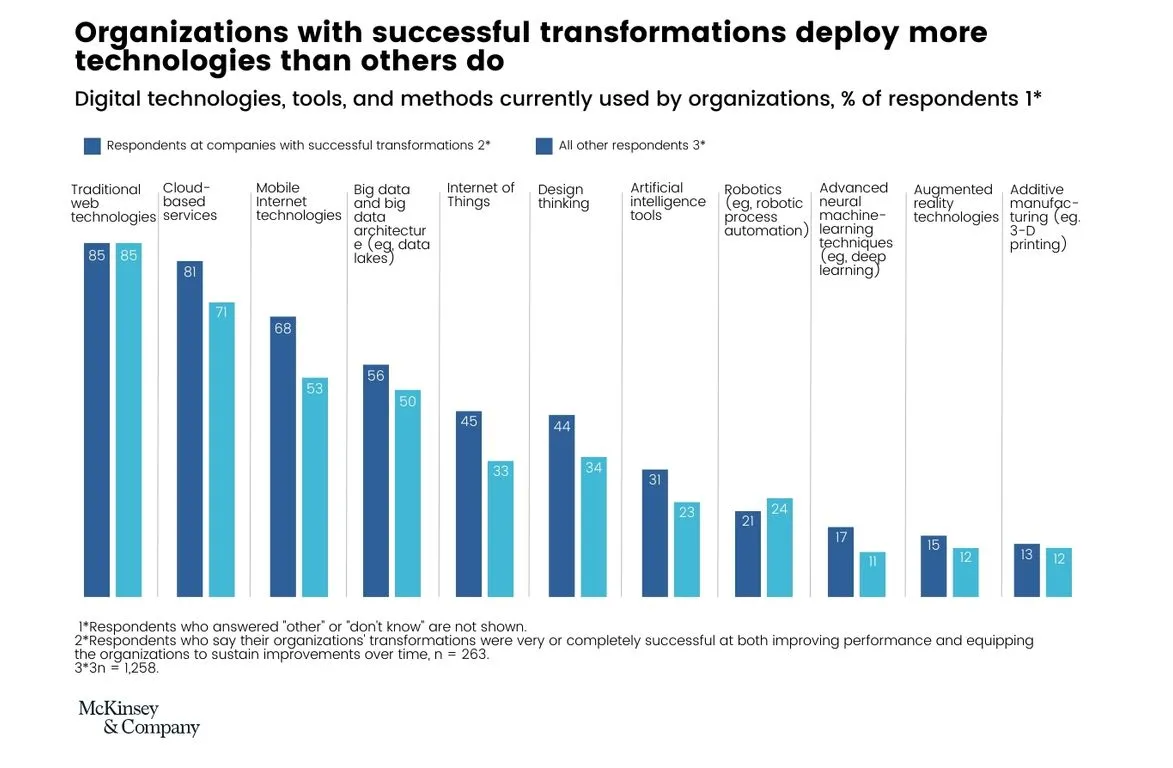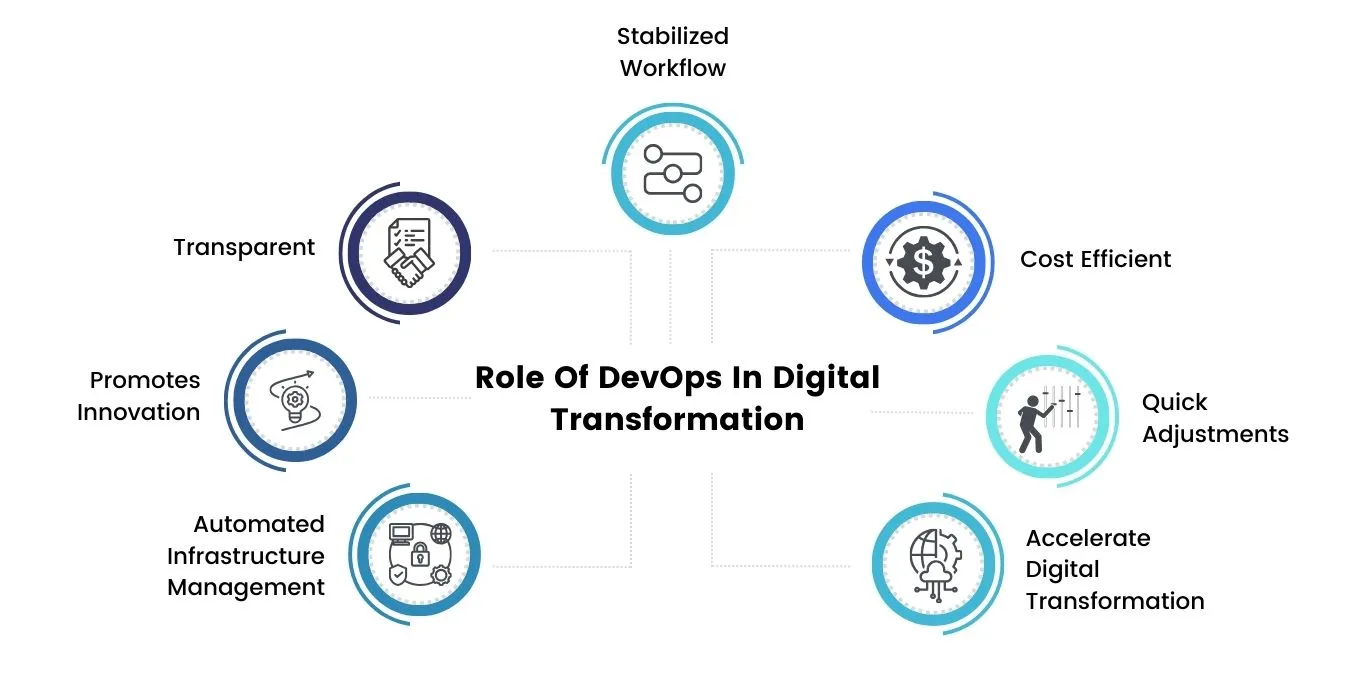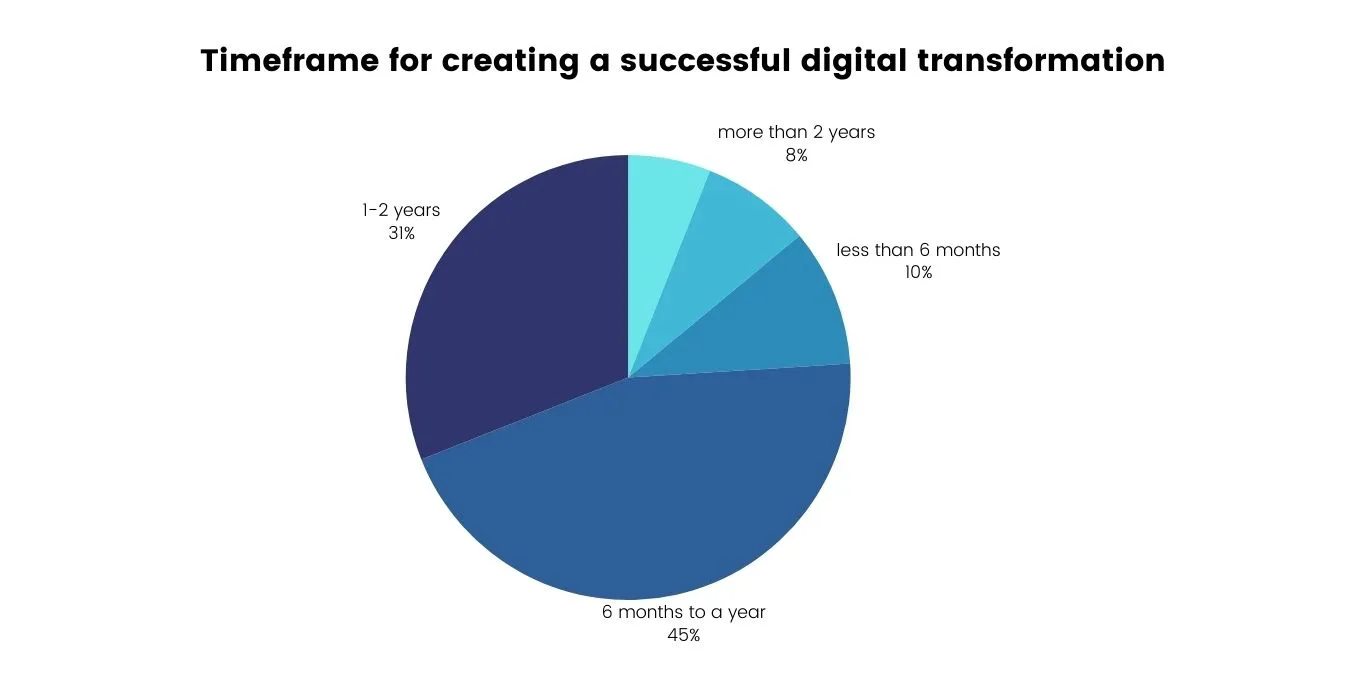Outsourcing to Czechia

How much does it cost to hire developers in Czechia?
Dec 2nd 25 - by Devico Team
Find out how much it costs to hire software developers in Czechia in 2025. Compare hourly rates, roles, and factors that impact pricing.
Hire
Hire by role
Hire Front-end developers
Hire Back-end developers
Hire Full-stack developers
Hire Android developers
Hire iOS developers
Hire Mobile developers
Hire AI engineers
Hire ML engineers
Hire Automation QA engineers
Hire Blockchain developers
Hire Data engineers
Hire Cloud engineers
Hire by skill
Hire JavaScript developers
Hire TypeScript developers
Hire Ruby on Rails developers
Hire React Native developers
Hire Flutter developers
Hire Golang developers
Hire React.js developers
Hire Python developers
Hire PHP developers
Hire .NET developers
Hire Java developers
Hire Laravel developers

DevOps
December 14, 2023 - by Devico Team
Summarize with:
Digital transformation is a (almost) new black. Digital transformation is the process of using digital technologies to create new business models, improve existing products and services, and enhance customer experiences. In general, this is a cultural shift — digital transformation morphs the way your teams think and business operates. It is a critical imperative for all-size businesses in today's digital-first world.
According to a recent McKinsey study, companies that have embraced digital transformation are outperforming their less-digitally mature peers by a significant margin. For example, the study found that digitally mature companies achieve 23% higher revenue growth, 24% higher profitability, and 19% higher customer satisfaction.

Yes, but. While the promise of digital transformation is compelling, the journey is far from straightforward. Organizations grapple with an array of challenges, ranging from legacy systems that resist integration to the ever-present threat of cyberattacks. In a survey conducted by EY, 50% of businesses cited the complexity of existing IT infrastructure as the primary obstacle to their digital transformation efforts. This complexity leads to project delays, cost overruns, and, in some cases, project failures.
Cybersecurity concerns are equally pressing. With the digital landscape constantly evolving, organizations must bolster their security measures to protect sensitive data. Need a proof? You’re welcome. As of 2023 only, companies lost USD 4.45M due to data breaches. Recall MOVEit or UK Electoral Commission cases.
And that’s where DevOps transformation comes into play. It is a set of practices that promotes collaboration and communication between development and IT operations teams. This methodology streamlines the software development and deployment process, allowing organizations to adapt swiftly to market demands and digital disruptions.
Example: Netflix. The streaming giant early adopted DevOps practices to deliver new features and updates at an astonishing pace. Through automated testing and continuous integration, Netflix ensures a seamless user experience. The company’s dev team is simply making hundreds of daily code changes. This level of agility is a testament to how DevOps technology can empower organizations to pivot swiftly in response to market demands, a pivotal aspect of successful digital transformation.
As we said earlier, DevOps is an entire culture and a set of practices that has reshaped the IT and software development landscape. Let's explore its definition, core principles, and its emergence as a response to the pressing need for more efficient software development and deployment.
DevOps, a portmanteau of "Development" and "Operations," is a collaborative approach that unites development and IT operations teams to streamline and automate the software delivery process. It hinges on three core principles:
Collaboration: DevOps fosters collaboration between traditionally siloed development and operations teams. This way, we have cross-functional teams that work together throughout the software development lifecycle, from planning and coding to testing and deployment.
Automation: Automation is the lifeblood of DevOps. Simply put, it’s a set of particular tools and technologies that help automate manual and repetitive tasks in the software delivery process. Automation accelerates the development pipeline, reduces errors, and ensures consistency in deployments.
Continuous Improvement: With DevOps, you’ll never be tranquil as you’ll always be looking for improvement. DevOps encourages teams to regularly reflect on their processes, identify bottlenecks, and seek ways to optimize and enhance efficiency. This iterative approach ensures that organizations can adapt to changing market demands swiftly.
DevOps emerged in response to the need for faster and more efficient software development and deployment. Traditional software development methodologies, such as the Waterfall model, were linear and time-consuming. They often led to protracted development cycles and hindered the timely release of new features or products.
The advent of the digital age brought about a need for agility. Businesses had to respond quickly to changing market dynamics and customer demands. DevOps filled this void by fostering a culture of collaboration and enabling automation. It shortened development cycles, reduced deployment errors, and improved the overall software quality.
You will likely agree that the most applicable part of any article is the examples. They are worth reading for their own sake, as they can be broken down into their component parts and put into practice in your own business. So, let’s explore several notable organizations that have embraced DevOps and witnessed remarkable improvements in their software delivery and business outcomes.
Amazon, for instance, adopted DevOps practices to deploy changes to its online retail platform every 11.7 seconds, leading to increased customer satisfaction and substantial revenue growth.
Another success story is Etsy, the online marketplace. By implementing DevOps, they achieved a significant reduction in their mean time to recovery and a 90% reduction in lead time for changes. By the way, the Etsy team conducts over 14,000 tests every single day. These moves obviously lead to a more responsive and competitive business.

How about dancing? Oh, just a “jokable” metaphor — imagine that digital transformation is a dancer. In this sense, DevOps is the perfect partner, sharing the same rhythm and steps toward organizational evolution. The alignment between DevOps and digital transformation goals is a vital key to unlocking the full potential of this intricate dance.
DevOps transformation helps companies to achieve the following goals by breaking down silos between development and operations teams, automating manual processes, and continuously improving their practices. This allows organizations to deliver software and services rapidly and reliably and to innovate swiftly.
Agility: The ability to swiftly respond to market changes and customer demands — that’s agility itself. DevOps is designed to deliver precisely this. By breaking down the unnecessary space between development and operations, organizations become nimble. They can adapt, innovate, and release new features and updates faster, meeting the dynamic expectations of the digital age.
Innovation: We cannot say with 100% certainty that innovation is an indispensable part of transformation. Previously invented tools and tactics in process design are also successfully applied. Yet, the importance of innovation cannot be denied. DevOps nurtures a culture of unconventional approaches and continuous experimentation. DevOps fosters collaboration, and hence, fresh ideas and diverse perspectives in the software development process appear on their own. This leads to the rapid creation of innovative solutions that can set a company apart, especially in the long run.
Customer-Centricity: Nothing groundbreaking: the customer is king, they are at the center of everything. DevOps streamlines the software development and deployment process, ensuring that customer feedback is rapidly incorporated into the development cycle. This customer-centric approach is fundamental to digital transformation, where meeting and exceeding customer expectations is paramount.
DevOps is, first and foremost, a cultural transformation. It redefines the way teams work together. By promoting collaboration between traditionally isolated development and operations teams, DevOps breaks down the walls of communication and fosters a culture of shared responsibility. This shift encourages a mutual understanding of each other's challenges, resulting in the creation of cross-functional teams that can deliver better results together.
Because automation is a great force, its role in digital transformation cannot be overstated. Automation accelerates repetitive and time-consuming tasks, reducing human error and ensuring consistency. By automating the testing, integration, and deployment processes, DevOps empowers organizations to move faster and with greater confidence.
Example: Google. They use automated testing and deployment processes, enabling them to make changes to their search algorithms swiftly and safely. Automation plays a critical role in their ability to maintain search quality while constantly improving and evolving their services. Their other project – Bard – also emphasizes the importance of automation. As it evolves, there is a need for repetitive testing of whether the AI model provides relevant results or not.
Anyways, automation is a game-changer. It allows organizations to scale their operations, respond to market changes, and innovate more effectively. It also frees up valuable human resources to focus on strategic tasks rather than routine, time-consuming activities.
About 55% of US companies are sure they will lose a market share in a year if they don’t start DevOps digital transformation immediately. But the path to it is not without its hurdles. To effectively obtain all the benefits of DevOps, organizations must navigate and overcome various challenges.

Cost Considerations: Implementing DevOps can be a substantial investment. Costs may encompass the acquisition of necessary tools and software, training for employees, and potential process changes. For smaller organizations with limited resources, the financial aspect can be a daunting challenge.
Cultural Resistance: Cultural resistance is one of the most formidable barriers. Transitioning to a DevOps culture involves redefining roles and responsibilities. These moves often scare those employees who are not so motivated to conquer new heights or something; simply put, who are comfortable with existing processes. So, all your efforts on breaking down gaps, which is one key purpose of DevOps, may face pushback.
Skill Gaps: Obviously, you need top-notch specialists. For any task, actually, but for the shift to DevOps even more. And there are two ways: either you hire skillful old-hand masters or nurture existing employees through training. But both ways can be a time-consuming and costly endeavor. Skill gaps can hinder the effectiveness of DevOps adoption.
Legacy Systems: Organizations with entrenched legacy systems often face integration challenges. These systems may be incompatible with DevOps principles, and transitioning from them can be a complex, resource-intensive process.
One more thing. These challenges are not all the difficulties you may encounter. Yeah, this’s a pity, but still. There are some pitfalls that may irritate you during your transformation journey.
Unclear plan: When you are in the dark about the finish point, you’ll get nowhere. So, it’s extremely important to have a clear plan before implementing DevOps. Goals of the DevOps initiative, the steps that will be taken to achieve those goals, and the metrics that will be used to measure success — all you need at this stage.
Disflingnment in the company: DevOps requires buy-in from all stakeholders, including development, operations, and management. Without buy-in, it will be difficult to achieve the desired results.
“Penny pincher-ing” in terms of training: One dollar invested in your workforce training could morph into ten dollars in future income after the DevOps implementation. But there is a thorny question — are you sure your so beloved workers won’t leave you after all that training? We don’t say you shouldn’t invest in your workforce at all, just do it wisely.
More automation: Automation is key when it comes to DevOps. Yet, some companies may be hesitant to automate certain tasks, such as testing and deployment. This can lead to bottlenecks and slow down the delivery of software and services.
Cost-Effective Implementation: To address cost concerns, organizations can adopt a phased approach to DevOps implementation. In any case, you always can keep the small pilot projects approach that will show if the game’s worth the candle. This approach can help secure buy-in and justify further investments.
Cultural Transformation: Cultural resistance can be mitigated through effective communication and training. Leadership should run a tight ship, emphasizing DevOps benefits and setting clear expectations. Providing training and resources to employees is essential to foster a culture of collaboration and shared responsibility.
Skill Development: To bridge skill gaps, organizations should invest in training and upskilling programs for their employees. As we said before, do it consciously. Let your “top players” obtain DevOps certifications from the top educational organizations and then scale this practice. Additionally, cultivating a learning culture where employees are encouraged to acquire new skills is invaluable.
Legacy System Integration: Addressing legacy systems involves a meticulous assessment of their compatibility with DevOps practices. In some cases, organizations may choose to refactor or replace legacy systems gradually. The key is to develop a well-defined strategy that ensures the integration of DevOps principles without disrupting critical business operations.
Example: Nordstrom. This is a renowned fashion retailer. Facing challenges in their digital transformation journey, they embraced DevOps to improve the speed and quality of their software releases. By taking a phased approach and providing training for their staff, they not only overcame cultural resistance but also enhanced their digital capabilities.
When on a digital transformation mission, follow a practical step-by-step guide below. We divided it into five steps for better perception, but you could joint the steps and tailor this guide to your company’s needs.
Before implementing DevOps, it's crucial to have a clear understanding of where you actually are in your journey and which areas need to be improved. This initial assessment provides a baseline for measuring progress. Start with:
Documenting existing workflows, tools, and methodologies (the Flowchart software, such as Visio or Lucidchart, and mind mapping tools like XMind will cover such needs).
Identifying bottlenecks, manual processes, and sources of delays through in-depth analysis.
Assessing the overall efficiency and effectiveness of your current software development and deployment lifecycle (Lead Time, MTTR, and even Team Velocity — you should know all the ins and outs).
DevOps integration should not be a haphazard effort but a well-defined strategy aligned with digital transformation objectives. This involves:
Goal-setting by SMART methodology for DevOps adoption.
Defining how DevOps will contribute to broader digital transformation goals, such as increased agility, improved customer experiences, or faster time to market.
Creating a roadmap that outlines the steps to achieving these objectives.
The heart of DevOps is collaboration. To foster this culture, organizations should:
Create cross-functional teams that include members from development, operations, and other relevant departments.
Encourage open communication and knowledge sharing among team members.
Promote shared ownership and responsibilities for the entire software development and deployment lifecycle.
Automation is the apple of the eye in DevOps. We mean, you should love it and appreciate its benefits. And use it, of course. To streamline processes and reduce manual efforts:
Identify areas where automation can be applied, such as code integration, testing, and deployment.
Invest in the right automation tools and technologies that align with your specific needs.
Automate repetitive tasks, including code testing, build processes, and infrastructure provisioning.
The journey doesn't end with implementation; it's an ongoing process of improvement. It’d be better to:
Implement monitoring and measurement tools to track the performance of DevOps practices: consider Nagios, Prometheus, or another that suits you.
Continuously collect and analyze data to identify areas for further optimization.
Regularly review and refine DevOps processes to adapt to changing business needs and technology trends.
Example: Amazon. A pioneer in DevOps adoption employs these steps effectively. Their teams regularly assess their processes, define clear DevOps goals aligned with their customer-centric mission, establish cross-functional teams, use automation tools extensively, and continuously monitor and optimize their DevOps practices to deliver rapid, reliable, and innovative solutions.
DevOps responds to the evolving demands of the tech market and, consequently, is set to undergo transformations and innovations. To turn the digital transformation race into a one-horse race, organizations must be attuned to emerging trends and technologies that shape the future of DevOps.
1/ AIOps (Artificial Intelligence for IT Operations): AIOps represents the convergence of artificial intelligence and DevOps. It leverages AI and machine learning to enhance operations, automate repetitive tasks, and provide intelligent insights into system performance. AIOps can predict and prevent issues, streamline troubleshooting, and optimize resource allocation, making it a valuable addition to the DevOps toolkit.
2/ Serverless Computing: Serverless computing simplifies application development and deployment by abstracting infrastructure management. DevOps teams can focus on code development and application logic while the cloud provider handles the underlying infrastructure. This trend aligns with the goal of reducing manual efforts and speeding up delivery.
3/ AI/ML Integration: Artificial intelligence and machine learning are becoming integral to DevOps processes. They are used for predictive analytics, anomaly detection, and performance optimization. AI-driven testing and continuous delivery pipelines can identify patterns, streamline code reviews, and enhance security through threat analysis.
4/ Evolution of DevOps Practices: DevOps practices themselves are evolving to meet the demands of modern businesses. Concepts like "DevSecOps," which emphasizes security throughout the development lifecycle, are gaining prominence. Additionally, organizations are exploring "GitOps" for declarative infrastructure management, further blurring the lines between development and operations.
DevOps stands as the lynchpin of successful digital transformation. It aligns with the core goals of agility, innovation, and customer-centricity, making it an essential asset for organizations striving to remain competitive in the rapidly changing digital landscape.
Embracing DevOps is a strategic necessity in the modern tech market. From its cultural impact to its automation capabilities, DevOps offers a holistic approach to meeting the demands of the digital age.
Organizations must not only recognize the significance of DevOps but also actively explore and implement its principles. The future of DevOps is promising, with emerging trends like AIOps, serverless computing, and AI/ML integration reshaping the landscape. To stay ahead, businesses must continually evolve their DevOps practices, align them with digital transformation goals, and remain adaptable in the face of technological advancements.
Outsourcing to Czechia

Dec 2nd 25 - by Devico Team
Find out how much it costs to hire software developers in Czechia in 2025. Compare hourly rates, roles, and factors that impact pricing.
Outsourcing to Czechia

Nov 25th 25 - by Devico Team
Compare Czechia and Poland for software outsourcing in 2025. Discover costs, talent, infrastructure, and which country fits your project best.
Outsourcing to Czechia

Nov 18th 25 - by Devico Team
A complete guide to outsourcing software projects to Czechia, learn about costs, talent, benefits, and how to build successful partnerships in 2025.